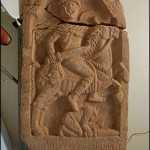 Contractors building an apartment complex in 2005 uncovered a unique Roman headstone from 100 A.D. with an intricately carved image of a Roman soldier holding the severed head of a barbarian.
Contractors building an apartment complex in 2005 uncovered a unique Roman headstone from 100 A.D. with an intricately carved image of a Roman soldier holding the severed head of a barbarian.
Stephen Bull, curator of Military History and Archaeology at Lancashire Museums Service, said there was a very good chance the stone depicts a real incident.
“The inscription tells us that the man was ranked as a curator in the Roman auxiliary,” he said.
“To depict him in such a dramatic and war-like position, when none of the other tombstones of this period show such a thing, makes it very likely that we are looking at something either real, or very similar to an event that happened.”
It’s funny, but I don’t think of beheading an enemy fighter and holding his head aloft as a particularly rare accomplishment in ancient battles. Perhaps it was, though. Certainly Roman swords were short jabbing things, not exactly suited to severing body parts.
The stone needs restoration, but is scheduled to go on public display in the Lancaster City Museum by December.
:skull: Beheading may have been fairly common, but memorialising this act in stone certainly was rare. The only other obvious example in the UK appears on a tablet from the Antonine wall.
If battlefield beheadings were indeed common at the time, I would think there must have been something in particular about the behaving depicted on the gravestone in order for it to get such a starring role. I don’t suppose we’ll even know, but I’m terribly curious about it nonetheless.
On another note, it is a genuine thrill to have the expert cited in an article comment to clarify a point. The kinds of stories I like to blog about tend to be sketchy on the details. :thanks: